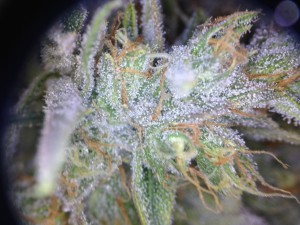Cannabis 101: THC, CBD, terpenes? The science of pot.
As the recreational marijuana business sector continues to grow, so does my realization that the rabbit hole of knowledge about the plant stretches far deeper than I could ever have thought.
I thought I’d try to go through some of the science type stuff in this post.
If you’re reading this blog (which means you’re awesome, by the way), you probably know what THC is. But just for the heck of it, let’s define it.

TCH is an acronym for delta-9-tetrahydrocannabidinol. It’s often described as the psychoactive component of the plant – the part that gives you a euphoric high. There are also several medical claims (and a handful of studies) about it helping with a variety of symptoms like appetite, nausea, neurological disorders, pain and spasms.
Here’s a video explaining THC:
[youtube=http://youtu.be/jgQFaP4A3hU]
THC is just one of a host of components in a marijuana plant called cannabanoids. Cannabanoids bind to natural receptors in the brain (called the endocannabinoid system) to produce a variety of effects.
Here’s a couple videos explaining how they work on the brain:
[youtube=http://youtu.be/oeF6rFN9org]
[youtube=http://youtu.be/E4ZSiHuPPik]
If you prefer to read, another good resource is How Stuff Works “How Marijuana Works” feature.
The next most popular component of cannabis – which Washington labs test for as part of I-502 – is something called CBD, or cannabidiol.

It’s a non-psychoactive component of the plant that has been associated with reducing anxiety, reducing pain and protecting against nerve damage, among other things.
Here’s a video explaining more about CBD:
[youtube=http://youtu.be/qG1_2REk-LQ]
One of the things that happened as the black market evolved is that growers started fostering growth of marijuana strains with large amounts of THC in them, often at the expense of CBD – since many customers on the black market recreational side were looking to get high rather than to use it as medicine.
As medical markets started to evolve, some growers in that sector began fostering strains with both CBD and THC – because (and there’s some, but not a lot of studies on this) the two work better in concert with the other compounds in the plant when it comes to fighting illness.

It’s also interesting to note that while THC and marijuana (although not CBD) are classified as Schedule I drugs by the U.S. government, saying its of no medical benefit, the government has at the same time approved at least one pharmaceutical derived from THC, Marinol. And the Food and Drug Administration also has a handful of other marijuana-derived drugs in the pipeline awaiting the go-ahead for clinical trials.
There’s more about that and research in general in this story I did earlier this year: Will legalization spark marijuana research?
One interesting thing that’s starting to appear in the I-502 recreational market, is that rec users are starting to ask for high CBD strains, often to help with some of the aches and pains of aging, said Katey Cooper of Monkey Grass Farms.
“We’re working on high THC and high CBD strains,” Cooper said. “CBD makes your body feel good and the THC gives you that couch lock high. We find a lot of Baby Boomers really want the high CBD strains because they want that body high.”
On the medical side, some CBD strains are over 20 percent or even higher. But on the recreational side so far, the highest that have reached the market in Vancouver are more around 1 or 2 percent at most.
Beyond the CBD and THC there are dozens of other cannabanoids in marijuana. I’ve heard anything from 60 to 130 of them.
Those other cannabanoids are also associated with various medical benefits, although the number of studies drops quite a bit when you get beyond CBD and THC.
The site ShortCannabisVideos has details on several others.
On the plant, the THC and other cannabanoids gather in tiny bubbles (the whiteish stuff you see on leaves) called trichomes.

But they’re not the only thing that gathers in there. Another component called terpenes also gathers in those whitish bubbles.
And if you talk to growers like CannaMan’s Shane Wahl, you’ll find they’re fascinated by them.
“Terpenes, they are the plant,” Wahl said. “It’s the aroma, it’s the texture, it’s the flavor, it’s the pungent feel in the back of your throat. It’s the plant’s essence.”
Labs are only just starting to test for some of them now, and there are hundreds of terpenes that are part of many plants, not just cannabis.
“Most people don’t know much about terpenes, but it changes the high,” said Dana Luce, owner of G.O.A.T. Labs, a testing facility in Vancouver. “It’s terpenes that control whether something is a creeper weed (takes a while to get you high) or gives you an ‘up’ high or couch lock.”
Here’s a video about them:
[youtube=http://youtu.be/3qmlgrQi1mU]
Luce, who said his lab can test for them, gave me a list of what a few of them are. Here’s the highlights:
Borneol: (smells like menthol, pine, camphor) Also found in cinnamon and wormwood. It’s considered a calming sedative in Chinese medicine.
Caryophyllene: (smells sweet, woody, clovey, peppery) Found in black pepper, cloves and cotton. As a topical it’s used as an anti-inflammatory and toothache treatment.
Limonene: (smells like citrus, orange, lemon, grapefruit) Found in rosemary, juniper and peppermint. With other terpenes it can turn into a anti-bacterial, anti-fungal, anti-carcinogenic and anti-depressant agent.
Myrcene: (Smells like cloves, earth, green vegetables, mango) Found in mangoes, hops, lemon grass. It has antimicrobial, antiseptic, antioxidant anti-inflammatory and muscle relaxing effects.
Pinene: (Smells like pine needles or rosemary) Found in dill, parsley, basil, rosemary, rose and hops. It can increase mental focus and energy, work as a brochodialator and topical antiseptic.
Wahl said as the recreational market continues to develop, he thinks growers will start to patent plants based on their terpene profile, rather than just strain genetics.
With all of these compounds and sub-compounds you can see that there’s a huge body of research just waiting for the drug to be reclassified federally. Right now, it’s hard for scientists to get their hands on samples to study because of the drug’s status.
Considering the long history of marijuana as folk medicine (hint: It’s been used all over the world for thousands of years) – and with advances in scientific techniques – it really is time to get this plant rescheduled.
Who knows what benefits scientists might find if they had more access to it.
Cheers,
-SueVo (sue.vorenberg@columbian.com)
